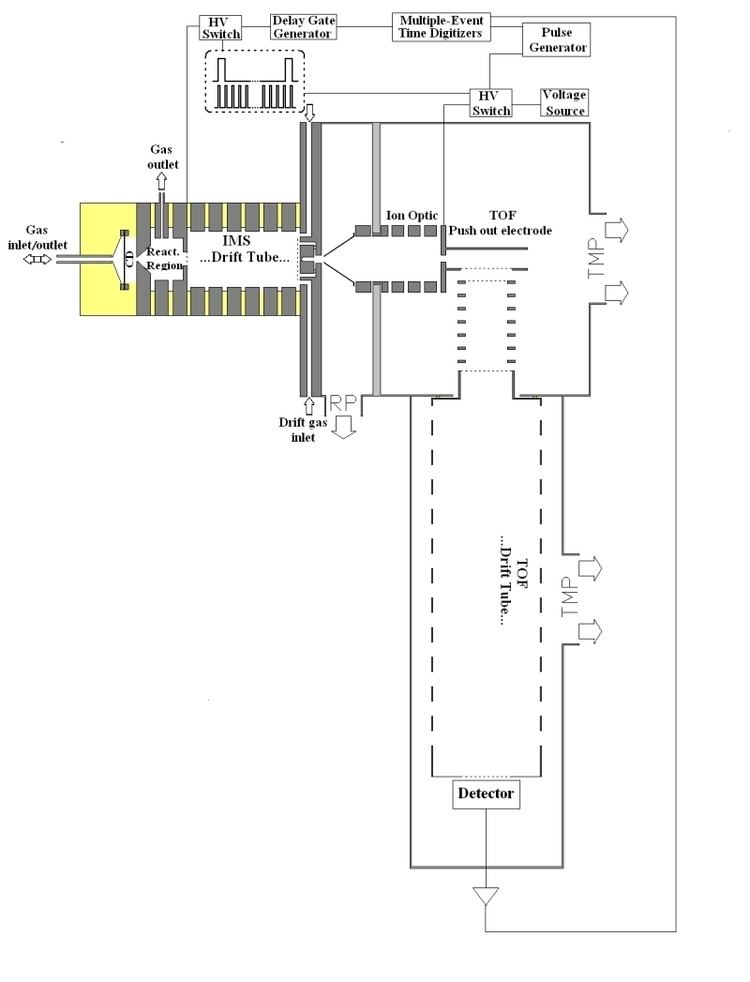 | ||
Ion-mobility spectrometry–mass spectrometry (IMS-MS), also known as ion-mobility separation–mass spectrometry, is an analytical chemistry method that separates gas phase ions on a millisecond timescale using ion-mobility spectrometry and uses mass spectrometry on a microsecond timescale to identify components in a sample.
Contents
History
Earl W. McDaniel has been called the father of ion mobility mass spectrometry. In the early 1960s, he coupled a low-field ion mobility drift cell to a sector mass spectrometer.
The combination of time-of-flight mass spectrometry and ion-mobility spectrometry was pioneered in 1963 at Bell Labs. In 1963 McAfee and Edelson published an IMS-TOF combination. In 1967 McKnight, McAfee and Sipler published an IMS-TOF combination. Their instrument included an orthogonal TOF. In 1969 Cohen et al. filed a patent on an IMS-QMS system. The QMS at that time was an improvement compared to the TOFMS, because the TOFMS had a slow electronic data acquisition systems at that time. In 1970, Young, Edelson and Falconer published an IMS-TOF with orthogonal extraction. They seem to have used the same system as McKnight et al. in 1967, incorporating slight modifications. Their work was later reproduced in the landmark book of Mason/McDaniel, which is regarded as the “bible of IMS” by those skilled in the art.
In 1996 Guevremont et al. presented a poster at the ASMS conference about IMS-TOF. In 1997 Tanner patented a quadrupole with axial fields which can be used as a drift cell for IMS separation. He also mentions the combination of these quadrupoles with an orthogonal TOFMS. In 1998 Clemmer developed an IMS-TOF combination, using a co-axial IMS-TOF setup. In 1999 Clemmer developed an IMS-TOF with an orthogonal TOF system. This work led to the development of an ion mobility-quadrupole-CID-TOFMS instrument by Micromass in the UK and ultimately led Micromass / Waters corporation to develop of the worlds first commercial ion mobility-mass spectrometer instrument in 2006. The Synapt, as it is called, incorporates a pre ion mobility quadrupole allowing precursor ion selection prior to IMS separation further enhancing the flexibility of the ion mobility-mass spectrometry combinations. In 2013, Agilent Technologies released the first commercial drift tube ion mobility-mass spectrometer named 6560 with an 80 cm drift tube. Ion funnels are used to promise the ion transmission efficiency. The design thus greatly improved the sensitivity of ion mobility and allowed commercialization.
Instrumentation
The IMS-MS is a combination of an ion-mobility spectrometer and a mass spectrometer.
First the ion mobility spectrometer separates ions according to their mobilities. In a second step the mass spectrometer separates ions according to their mass-to-charge ratio. Such a combination is often referred to as a hyphenated separation or multi-dimensional separation.
There are different types of ion mobility spectrometers and there are different types of mass spectrometers. In principle it is possible to combine every type of the former with any type of the latter. However, in the real world, different types of ion mobility are coupled with different types of mass spectrometers to achieve reasonable sensitivity (will be discussed later).
Types of IMS-MS include drift tube IMS (DT IMS) or the traditional ion mobility spectrometer, DMS differential mobility spectrometer, a scanable filter, also called FAIMS, and DMA differential mobility analyzer, a scanable filter.
Drift tube ion mobility does not employ RF voltage which may heat ions, and it can preserve the structure of the ions. The rotationally averaged collision cross section (CCS) which is a physical property of ions reflecting the shape of the ions can be measured accurately on drift tube ion mobility. The resolving power is high (CCS resolution can be higher than 100). Drift tube ion mobility is widely used for structure analysis. It is usually coupled with time-of-flight (TOF) mass spectrometer.
High-field asymmetric-waveform ion-mobility spectrometry (FAIMS or RF-DC ion-mobility spectrometry) is a mass spectrometry technique in which ions at atmospheric pressure are separated by the application of a high-voltage asymmetric waveform at radio frequency (RF) combined with a static (DC) waveform applied between two electrodes. Depending on the ratio of the high-field and low-field mobility of the ion, it will migrate toward one or the other electrode. Only ions with specific mobility will pass through the device. It is well known that the high RF field distort the conformation of the ions, FAIMS thus is a separation technique without reserving the structure of the ions and the CCSs of the ions cannot be measured. Because FAIMS is a mass selector (other ions are excluded), the sensitivity in the scan mode is much lower than that of the drift tube ion mobility (all the ions are analyzed). Therefore, FAIMS is usually coupled with triple quadrupole mass spectrometer which is also ion selection type instrument.
Applications
The IM-MS technique can be used for analyzing complex mixtures based on differing mobilities in an electric field. The gas-phase ion structure can be studied using IM-MS through measurement of the CCS and comparison with CCS of standard samples or CCS calculated from molecular modelling. The signal-to-noise ratio is obviously improved because the noise can be physically separated with signal in IM-MS. In addition, isomers can be separated if their shapes are different. The peak capacity of IM-MS is much larger than MS so more compounds can be found and analyzed. This character is very critical for -omics study which requires analyzing as many compounds as possible in a single run. It has been used in the detection of chemical warfare agents, detection of explosives, in proteomics for the analysis of proteins, peptides, drug-like molecules and nano particles.{}
